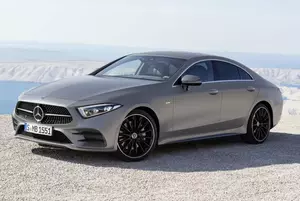
| Vehicle | Curb weight | Difference from world's smallest | Weight to power ratio | 0—60 mph acceleration ratio | Consumption ratio |
|---|---|---|---|---|---|
| CLS 350 d |
1860 kg / 4101 lbs |
1435 kg (3164 lbs) heavier | 7 kg to 1 hp | 344 kg/s (759 lbs/s) |
332 kg/L (732 lbs/L) |
| CLS 400 d |
1860 kg / 4101 lbs |
1435 kg (3164 lbs) heavier | 5 kg to 1 hp | 388 kg/s (856 lbs/s) |
332 kg/L (732 lbs/L) |
| CLS 450 |
1865 kg / 4112 lbs |
1440 kg (3175 lbs) heavier | 5 kg to 1 hp | 405 kg/s (893 lbs/s) |
249 kg/L (549 lbs/L) |
| AMG CLS 53 |
1980 kg / 4366 lbs |
1555 kg (3429 lbs) heavier | 5 kg to 1 hp | 460 kg/s (1014 lbs/s) |
228 kg/L (503 lbs/L) |
| CLS 300 d |
1750 kg / 3859 lbs |
1325 kg (2922 lbs) heavier | 7 kg to 1 hp | 287 kg/s (633 lbs/s) |
337 kg/L (743 lbs/L) |
| CLS 350 |
1775 kg / 3914 lbs |
1350 kg (2977 lbs) heavier | 6 kg to 1 hp | 311 kg/s (686 lbs/s) |
225 kg/L (496 lbs/L) |
| CLS 220d |
1715 kg / 3782 lbs |
1290 kg (2845 lbs) heavier | 9 kg to 1 hp | 242 kg/s (534 lbs/s) |
365 kg/L (805 lbs/L) |
| Vehicle | CLS 350 d |
|---|---|
| Curb weight |
1860 kg / 4101 lbs |
| Difference from world's smallest | 1435 kg (1435 lbs) heavier |
| Weight to power ratio | 7 kg to 1 hp |
| 0—60 mph acceleration ratio | 344 kg/s (759 lbs/s) |
| Consumption ratio |
332 kg/L (732 lbs/L) |
| Vehicle | CLS 400 d |
| Curb weight |
1860 kg / 4101 lbs |
| Difference from world's smallest | 1435 kg (1435 lbs) heavier |
| Weight to power ratio | 5 kg to 1 hp |
| 0—60 mph acceleration ratio | 388 kg/s (856 lbs/s) |
| Consumption ratio |
332 kg/L (732 lbs/L) |
| Vehicle | CLS 450 |
| Curb weight |
1865 kg / 4112 lbs |
| Difference from world's smallest | 1440 kg (1440 lbs) heavier |
| Weight to power ratio | 5 kg to 1 hp |
| 0—60 mph acceleration ratio | 405 kg/s (893 lbs/s) |
| Consumption ratio |
249 kg/L (549 lbs/L) |
| Vehicle | AMG CLS 53 |
| Curb weight |
1980 kg / 4366 lbs |
| Difference from world's smallest | 1555 kg (1555 lbs) heavier |
| Weight to power ratio | 5 kg to 1 hp |
| 0—60 mph acceleration ratio | 460 kg/s (1014 lbs/s) |
| Consumption ratio |
228 kg/L (503 lbs/L) |
| Vehicle | CLS 300 d |
| Curb weight |
1750 kg / 3859 lbs |
| Difference from world's smallest | 1325 kg (1325 lbs) heavier |
| Weight to power ratio | 7 kg to 1 hp |
| 0—60 mph acceleration ratio | 287 kg/s (633 lbs/s) |
| Consumption ratio |
337 kg/L (743 lbs/L) |
| Vehicle | CLS 350 |
| Curb weight |
1775 kg / 3914 lbs |
| Difference from world's smallest | 1350 kg (1350 lbs) heavier |
| Weight to power ratio | 6 kg to 1 hp |
| 0—60 mph acceleration ratio | 311 kg/s (686 lbs/s) |
| Consumption ratio |
225 kg/L (496 lbs/L) |
| Vehicle | CLS 220d |
| Curb weight |
1715 kg / 3782 lbs |
| Difference from world's smallest | 1290 kg (1290 lbs) heavier |
| Weight to power ratio | 9 kg to 1 hp |
| 0—60 mph acceleration ratio | 242 kg/s (534 lbs/s) |
| Consumption ratio |
365 kg/L (805 lbs/L) |

| Vehicle | Curb weight | Difference from world's smallest | Weight to power ratio | 0—60 mph acceleration ratio | Consumption ratio |
|---|---|---|---|---|---|
| CLS 220 |
1770 kg / 3903 lbs |
1345 kg (2966 lbs) heavier | 10 kg to 1 hp | 216 kg/s (476 lbs/s) |
361 kg/L (796 lbs/L) |
| CLS 250 |
1880 kg / 4145 lbs |
1455 kg (3208 lbs) heavier | 9 kg to 1 hp | 244 kg/s (538 lbs/s) |
342 kg/L (754 lbs/L) |
| CLS 350 |
1995 kg / 4399 lbs |
1570 kg (3462 lbs) heavier | 8 kg to 1 hp | 307 kg/s (677 lbs/s) |
293 kg/L (646 lbs/L) |
| CLS 400 |
1770 kg / 3903 lbs |
1345 kg (2966 lbs) heavier | 5 kg to 1 hp | 347 kg/s (765 lbs/s) | - |
| CLS 500 |
1930 kg / 4256 lbs |
1505 kg (3319 lbs) heavier | 5 kg to 1 hp | 420 kg/s (926 lbs/s) |
208 kg/L (459 lbs/L) |
| AMG CLS 63 |
2025 kg / 4465 lbs |
1600 kg (3528 lbs) heavier | 4 kg to 1 hp | 563 kg/s (1241 lbs/s) |
191 kg/L (421 lbs/L) |
| AMG CLS 63 S |
1950 kg / 4300 lbs |
1525 kg (3363 lbs) heavier | 3 kg to 1 hp | 557 kg/s (1228 lbs/s) |
184 kg/L (406 lbs/L) |
| CLS 350 d |
1920 kg / 4234 lbs |
1495 kg (3297 lbs) heavier | 7 kg to 1 hp | 310 kg/s (684 lbs/s) |
310 kg/L (684 lbs/L) |
| Vehicle | CLS 220 |
|---|---|
| Curb weight |
1770 kg / 3903 lbs |
| Difference from world's smallest | 1345 kg (1345 lbs) heavier |
| Weight to power ratio | 10 kg to 1 hp |
| 0—60 mph acceleration ratio | 216 kg/s (476 lbs/s) |
| Consumption ratio |
361 kg/L (796 lbs/L) |
| Vehicle | CLS 250 |
| Curb weight |
1880 kg / 4145 lbs |
| Difference from world's smallest | 1455 kg (1455 lbs) heavier |
| Weight to power ratio | 9 kg to 1 hp |
| 0—60 mph acceleration ratio | 244 kg/s (538 lbs/s) |
| Consumption ratio |
342 kg/L (754 lbs/L) |
| Vehicle | CLS 350 |
| Curb weight |
1995 kg / 4399 lbs |
| Difference from world's smallest | 1570 kg (1570 lbs) heavier |
| Weight to power ratio | 8 kg to 1 hp |
| 0—60 mph acceleration ratio | 307 kg/s (677 lbs/s) |
| Consumption ratio |
293 kg/L (646 lbs/L) |
| Vehicle | CLS 400 |
| Curb weight |
1770 kg / 3903 lbs |
| Difference from world's smallest | 1345 kg (1345 lbs) heavier |
| Weight to power ratio | 5 kg to 1 hp |
| 0—60 mph acceleration ratio | 347 kg/s (765 lbs/s) |
| Consumption ratio | - |
| Vehicle | CLS 500 |
| Curb weight |
1930 kg / 4256 lbs |
| Difference from world's smallest | 1505 kg (1505 lbs) heavier |
| Weight to power ratio | 5 kg to 1 hp |
| 0—60 mph acceleration ratio | 420 kg/s (926 lbs/s) |
| Consumption ratio |
208 kg/L (459 lbs/L) |
| Vehicle | AMG CLS 63 |
| Curb weight |
2025 kg / 4465 lbs |
| Difference from world's smallest | 1600 kg (1600 lbs) heavier |
| Weight to power ratio | 4 kg to 1 hp |
| 0—60 mph acceleration ratio | 563 kg/s (1241 lbs/s) |
| Consumption ratio |
191 kg/L (421 lbs/L) |
| Vehicle | AMG CLS 63 S |
| Curb weight |
1950 kg / 4300 lbs |
| Difference from world's smallest | 1525 kg (1525 lbs) heavier |
| Weight to power ratio | 3 kg to 1 hp |
| 0—60 mph acceleration ratio | 557 kg/s (1228 lbs/s) |
| Consumption ratio |
184 kg/L (406 lbs/L) |
| Vehicle | CLS 350 d |
| Curb weight |
1920 kg / 4234 lbs |
| Difference from world's smallest | 1495 kg (1495 lbs) heavier |
| Weight to power ratio | 7 kg to 1 hp |
| 0—60 mph acceleration ratio | 310 kg/s (684 lbs/s) |
| Consumption ratio |
310 kg/L (684 lbs/L) |
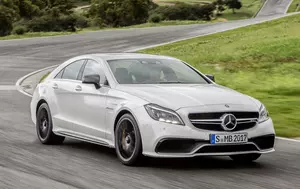
| Vehicle | Curb weight | Difference from world's smallest | Weight to power ratio | 0—60 mph acceleration ratio | Consumption ratio |
|---|---|---|---|---|---|
| CLS 250 |
1875 kg / 4134 lbs |
1450 kg (3197 lbs) heavier | 9 kg to 1 hp | 250 kg/s (551 lbs/s) |
354 kg/L (781 lbs/L) |
| CLS 220 |
1790 kg / 3947 lbs |
1365 kg (3010 lbs) heavier | 11 kg to 1 hp | 227 kg/s (501 lbs/s) |
381 kg/L (840 lbs/L) |
| CLS 350 |
1915 kg / 4223 lbs |
1490 kg (3286 lbs) heavier | 8 kg to 1 hp | 299 kg/s (659 lbs/s) |
309 kg/L (681 lbs/L) |
| AMG CLS 63 |
1945 kg / 4289 lbs |
1520 kg (3352 lbs) heavier | 3 kg to 1 hp | 556 kg/s (1226 lbs/s) |
187 kg/L (412 lbs/L) |
| CLS 400 |
1835 kg / 4046 lbs |
1410 kg (3109 lbs) heavier | 6 kg to 1 hp | 367 kg/s (809 lbs/s) |
229 kg/L (505 lbs/L) |
| CLS 500 |
1940 kg / 4278 lbs |
1515 kg (3341 lbs) heavier | 5 kg to 1 hp | 422 kg/s (931 lbs/s) |
202 kg/L (445 lbs/L) |
| AMG CLS 63 S |
1945 kg / 4289 lbs |
1520 kg (3352 lbs) heavier | 3 kg to 1 hp | 572 kg/s (1261 lbs/s) |
187 kg/L (412 lbs/L) |
| Vehicle | CLS 250 |
|---|---|
| Curb weight |
1875 kg / 4134 lbs |
| Difference from world's smallest | 1450 kg (1450 lbs) heavier |
| Weight to power ratio | 9 kg to 1 hp |
| 0—60 mph acceleration ratio | 250 kg/s (551 lbs/s) |
| Consumption ratio |
354 kg/L (781 lbs/L) |
| Vehicle | CLS 220 |
| Curb weight |
1790 kg / 3947 lbs |
| Difference from world's smallest | 1365 kg (1365 lbs) heavier |
| Weight to power ratio | 11 kg to 1 hp |
| 0—60 mph acceleration ratio | 227 kg/s (501 lbs/s) |
| Consumption ratio |
381 kg/L (840 lbs/L) |
| Vehicle | CLS 350 |
| Curb weight |
1915 kg / 4223 lbs |
| Difference from world's smallest | 1490 kg (1490 lbs) heavier |
| Weight to power ratio | 8 kg to 1 hp |
| 0—60 mph acceleration ratio | 299 kg/s (659 lbs/s) |
| Consumption ratio |
309 kg/L (681 lbs/L) |
| Vehicle | AMG CLS 63 |
| Curb weight |
1945 kg / 4289 lbs |
| Difference from world's smallest | 1520 kg (1520 lbs) heavier |
| Weight to power ratio | 3 kg to 1 hp |
| 0—60 mph acceleration ratio | 556 kg/s (1226 lbs/s) |
| Consumption ratio |
187 kg/L (412 lbs/L) |
| Vehicle | CLS 400 |
| Curb weight |
1835 kg / 4046 lbs |
| Difference from world's smallest | 1410 kg (1410 lbs) heavier |
| Weight to power ratio | 6 kg to 1 hp |
| 0—60 mph acceleration ratio | 367 kg/s (809 lbs/s) |
| Consumption ratio |
229 kg/L (505 lbs/L) |
| Vehicle | CLS 500 |
| Curb weight |
1940 kg / 4278 lbs |
| Difference from world's smallest | 1515 kg (1515 lbs) heavier |
| Weight to power ratio | 5 kg to 1 hp |
| 0—60 mph acceleration ratio | 422 kg/s (931 lbs/s) |
| Consumption ratio |
202 kg/L (445 lbs/L) |
| Vehicle | AMG CLS 63 S |
| Curb weight |
1945 kg / 4289 lbs |
| Difference from world's smallest | 1520 kg (1520 lbs) heavier |
| Weight to power ratio | 3 kg to 1 hp |
| 0—60 mph acceleration ratio | 572 kg/s (1261 lbs/s) |
| Consumption ratio |
187 kg/L (412 lbs/L) |
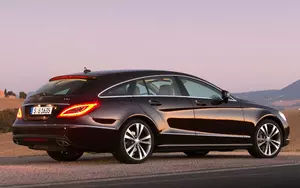
| Vehicle | Curb weight | Difference from world's smallest | Weight to power ratio | 0—60 mph acceleration ratio | Consumption ratio |
|---|---|---|---|---|---|
| CLS 250 CDI |
1865 kg / 4112 lbs |
1440 kg (3175 lbs) heavier | 9 kg to 1 hp | 252 kg/s (556 lbs/s) |
345 kg/L (761 lbs/L) |
| CLS 500 |
2005 kg / 4421 lbs |
1580 kg (3484 lbs) heavier | 5 kg to 1 hp | 427 kg/s (942 lbs/s) |
203 kg/L (448 lbs/L) |
| CLS 350 CDI |
1970 kg / 4344 lbs |
1545 kg (3407 lbs) heavier | 7 kg to 1 hp | 308 kg/s (679 lbs/s) |
294 kg/L (648 lbs/L) |
| CLS 350 |
1830 kg / 4035 lbs |
1405 kg (3098 lbs) heavier | 6 kg to 1 hp | 286 kg/s (631 lbs/s) |
247 kg/L (545 lbs/L) |
| AMG CLS 63 |
2025 kg / 4465 lbs |
1600 kg (3528 lbs) heavier | 3 kg to 1 hp | 579 kg/s (1277 lbs/s) |
191 kg/L (421 lbs/L) |
| Vehicle | CLS 250 CDI |
|---|---|
| Curb weight |
1865 kg / 4112 lbs |
| Difference from world's smallest | 1440 kg (1440 lbs) heavier |
| Weight to power ratio | 9 kg to 1 hp |
| 0—60 mph acceleration ratio | 252 kg/s (556 lbs/s) |
| Consumption ratio |
345 kg/L (761 lbs/L) |
| Vehicle | CLS 500 |
| Curb weight |
2005 kg / 4421 lbs |
| Difference from world's smallest | 1580 kg (1580 lbs) heavier |
| Weight to power ratio | 5 kg to 1 hp |
| 0—60 mph acceleration ratio | 427 kg/s (942 lbs/s) |
| Consumption ratio |
203 kg/L (448 lbs/L) |
| Vehicle | CLS 350 CDI |
| Curb weight |
1970 kg / 4344 lbs |
| Difference from world's smallest | 1545 kg (1545 lbs) heavier |
| Weight to power ratio | 7 kg to 1 hp |
| 0—60 mph acceleration ratio | 308 kg/s (679 lbs/s) |
| Consumption ratio |
294 kg/L (648 lbs/L) |
| Vehicle | CLS 350 |
| Curb weight |
1830 kg / 4035 lbs |
| Difference from world's smallest | 1405 kg (1405 lbs) heavier |
| Weight to power ratio | 6 kg to 1 hp |
| 0—60 mph acceleration ratio | 286 kg/s (631 lbs/s) |
| Consumption ratio |
247 kg/L (545 lbs/L) |
| Vehicle | AMG CLS 63 |
| Curb weight |
2025 kg / 4465 lbs |
| Difference from world's smallest | 1600 kg (1600 lbs) heavier |
| Weight to power ratio | 3 kg to 1 hp |
| 0—60 mph acceleration ratio | 579 kg/s (1277 lbs/s) |
| Consumption ratio |
191 kg/L (421 lbs/L) |
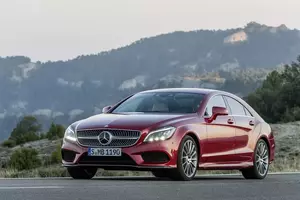
| Vehicle | Curb weight | Difference from world's smallest | Weight to power ratio | 0—60 mph acceleration ratio | Consumption ratio |
|---|---|---|---|---|---|
| CLS 500 |
1940 kg / 4278 lbs |
1515 kg (3341 lbs) heavier | 5 kg to 1 hp | 422 kg/s (931 lbs/s) |
200 kg/L (441 lbs/L) |
| CLS 350 CDI |
1875 kg / 4134 lbs |
1450 kg (3197 lbs) heavier | 7 kg to 1 hp | 307 kg/s (677 lbs/s) |
272 kg/L (600 lbs/L) |
| CLS 350 |
1935 kg / 4267 lbs |
1510 kg (3330 lbs) heavier | 8 kg to 1 hp | 302 kg/s (666 lbs/s) |
312 kg/L (688 lbs/L) |
| CLS 250 CDI |
1785 kg / 3936 lbs |
1360 kg (2999 lbs) heavier | 9 kg to 1 hp | 251 kg/s (553 lbs/s) |
337 kg/L (743 lbs/L) |
| AMG CLS 63 |
1870 kg / 4123 lbs |
1445 kg (3186 lbs) heavier | 3 kg to 1 hp | 468 kg/s (1032 lbs/s) |
189 kg/L (417 lbs/L) |
| Vehicle | CLS 500 |
|---|---|
| Curb weight |
1940 kg / 4278 lbs |
| Difference from world's smallest | 1515 kg (1515 lbs) heavier |
| Weight to power ratio | 5 kg to 1 hp |
| 0—60 mph acceleration ratio | 422 kg/s (931 lbs/s) |
| Consumption ratio |
200 kg/L (441 lbs/L) |
| Vehicle | CLS 350 CDI |
| Curb weight |
1875 kg / 4134 lbs |
| Difference from world's smallest | 1450 kg (1450 lbs) heavier |
| Weight to power ratio | 7 kg to 1 hp |
| 0—60 mph acceleration ratio | 307 kg/s (677 lbs/s) |
| Consumption ratio |
272 kg/L (600 lbs/L) |
| Vehicle | CLS 350 |
| Curb weight |
1935 kg / 4267 lbs |
| Difference from world's smallest | 1510 kg (1510 lbs) heavier |
| Weight to power ratio | 8 kg to 1 hp |
| 0—60 mph acceleration ratio | 302 kg/s (666 lbs/s) |
| Consumption ratio |
312 kg/L (688 lbs/L) |
| Vehicle | CLS 250 CDI |
| Curb weight |
1785 kg / 3936 lbs |
| Difference from world's smallest | 1360 kg (1360 lbs) heavier |
| Weight to power ratio | 9 kg to 1 hp |
| 0—60 mph acceleration ratio | 251 kg/s (553 lbs/s) |
| Consumption ratio |
337 kg/L (743 lbs/L) |
| Vehicle | AMG CLS 63 |
| Curb weight |
1870 kg / 4123 lbs |
| Difference from world's smallest | 1445 kg (1445 lbs) heavier |
| Weight to power ratio | 3 kg to 1 hp |
| 0—60 mph acceleration ratio | 468 kg/s (1032 lbs/s) |
| Consumption ratio |
189 kg/L (417 lbs/L) |
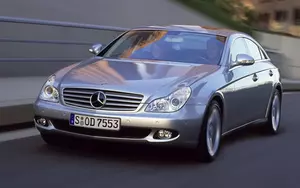
| Vehicle | Curb weight | Difference from world's smallest | Weight to power ratio | 0—60 mph acceleration ratio | Consumption ratio |
|---|---|---|---|---|---|
| CLS 350 CGI |
1660 kg / 3660 lbs |
1235 kg (2723 lbs) heavier | 6 kg to 1 hp | 259 kg/s (571 lbs/s) |
182 kg/L (401 lbs/L) |
| AMG CLS 63 |
1830 kg / 4035 lbs |
1405 kg (3098 lbs) heavier | 4 kg to 1 hp | 426 kg/s (939 lbs/s) |
126 kg/L (278 lbs/L) |
| CLS 320 CDI |
1740 kg / 3837 lbs |
1315 kg (2900 lbs) heavier | 8 kg to 1 hp | 260 kg/s (573 lbs/s) |
229 kg/L (505 lbs/L) |
| CLS 500 |
1760 kg / 3881 lbs |
1335 kg (2944 lbs) heavier | 5 kg to 1 hp | 345 kg/s (761 lbs/s) |
150 kg/L (331 lbs/L) |
| Vehicle | CLS 350 CGI |
|---|---|
| Curb weight |
1660 kg / 3660 lbs |
| Difference from world's smallest | 1235 kg (1235 lbs) heavier |
| Weight to power ratio | 6 kg to 1 hp |
| 0—60 mph acceleration ratio | 259 kg/s (571 lbs/s) |
| Consumption ratio |
182 kg/L (401 lbs/L) |
| Vehicle | AMG CLS 63 |
| Curb weight |
1830 kg / 4035 lbs |
| Difference from world's smallest | 1405 kg (1405 lbs) heavier |
| Weight to power ratio | 4 kg to 1 hp |
| 0—60 mph acceleration ratio | 426 kg/s (939 lbs/s) |
| Consumption ratio |
126 kg/L (278 lbs/L) |
| Vehicle | CLS 320 CDI |
| Curb weight |
1740 kg / 3837 lbs |
| Difference from world's smallest | 1315 kg (1315 lbs) heavier |
| Weight to power ratio | 8 kg to 1 hp |
| 0—60 mph acceleration ratio | 260 kg/s (573 lbs/s) |
| Consumption ratio |
229 kg/L (505 lbs/L) |
| Vehicle | CLS 500 |
| Curb weight |
1760 kg / 3881 lbs |
| Difference from world's smallest | 1335 kg (1335 lbs) heavier |
| Weight to power ratio | 5 kg to 1 hp |
| 0—60 mph acceleration ratio | 345 kg/s (761 lbs/s) |
| Consumption ratio |
150 kg/L (331 lbs/L) |
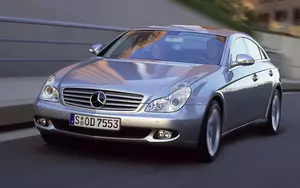
| Vehicle | Curb weight | Difference from world's smallest | Weight to power ratio | 0—60 mph acceleration ratio | Consumption ratio |
|---|---|---|---|---|---|
| CLS 500 |
1735 kg / 3826 lbs |
1310 kg (2889 lbs) heavier | 6 kg to 1 hp | 299 kg/s (659 lbs/s) |
154 kg/L (340 lbs/L) |
| AMG CLS 55 |
1845 kg / 4068 lbs |
1420 kg (3131 lbs) heavier | 4 kg to 1 hp | 410 kg/s (904 lbs/s) |
136 kg/L (300 lbs/L) |
| CLS 320 CDI |
1740 kg / 3837 lbs |
1315 kg (2900 lbs) heavier | 8 kg to 1 hp | 260 kg/s (573 lbs/s) |
229 kg/L (505 lbs/L) |
| CLS 350 |
1655 kg / 3649 lbs |
1230 kg (2712 lbs) heavier | 6 kg to 1 hp | 247 kg/s (545 lbs/s) |
164 kg/L (362 lbs/L) |
| Vehicle | CLS 500 |
|---|---|
| Curb weight |
1735 kg / 3826 lbs |
| Difference from world's smallest | 1310 kg (1310 lbs) heavier |
| Weight to power ratio | 6 kg to 1 hp |
| 0—60 mph acceleration ratio | 299 kg/s (659 lbs/s) |
| Consumption ratio |
154 kg/L (340 lbs/L) |
| Vehicle | AMG CLS 55 |
| Curb weight |
1845 kg / 4068 lbs |
| Difference from world's smallest | 1420 kg (1420 lbs) heavier |
| Weight to power ratio | 4 kg to 1 hp |
| 0—60 mph acceleration ratio | 410 kg/s (904 lbs/s) |
| Consumption ratio |
136 kg/L (300 lbs/L) |
| Vehicle | CLS 320 CDI |
| Curb weight |
1740 kg / 3837 lbs |
| Difference from world's smallest | 1315 kg (1315 lbs) heavier |
| Weight to power ratio | 8 kg to 1 hp |
| 0—60 mph acceleration ratio | 260 kg/s (573 lbs/s) |
| Consumption ratio |
229 kg/L (505 lbs/L) |
| Vehicle | CLS 350 |
| Curb weight |
1655 kg / 3649 lbs |
| Difference from world's smallest | 1230 kg (1230 lbs) heavier |
| Weight to power ratio | 6 kg to 1 hp |
| 0—60 mph acceleration ratio | 247 kg/s (545 lbs/s) |
| Consumption ratio |
164 kg/L (362 lbs/L) |